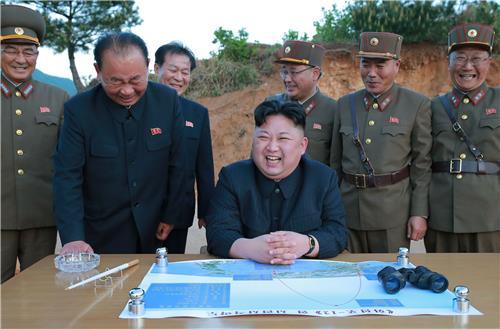How far along is ‘decapitation plan’ on Kim Jong-un?
By Sohn Ji-youngPublished : July 9, 2017 - 18:06
A day after North Korea launched what they claimed to be an intercontinental ballistic missile capable of carrying a large nuclear warhead, South Korea’s military on Wednesday released a computer-animated video showing missile strikes at the heart of Pyongyang.
The one-minute video clip included footage of destroying a command post of the North Korean People’s Armed Forces’ Ministry, with a long-range high-precision missile Taurus, a German-missile thought to be accurate enough to hit the office of North Korean leader Kim Jong-un.
The airstrike image is a part of “Korea Massive Punishment and Retaliation” scheme -- often dubbed “decapitation plan” -- a military campaign designed to demolish Pyongyang’s leadership with ballistic and cruise missiles in the event of an imminent nuclear attack.
With North Korea inching closer than ever before to developing a nuclear-tipped ICBM capable of hitting the US mainland, the attention is now on how advanced the campaign has developed and whether it would work as an effective deterrence against the North.

In January, South Korea’s Defense Ministry announced a plan to create a special brigade tasked with neutralizing North Korea’s wartime command-and-control system by eliminating the regime’s leadership including Kim Jong-un.
“Creating the special brigade before this year was incorporated as a basic plan for defense policy. The unit is designed to eliminate North Korea’s leadership and neutralize its function,” the ministry said in a statement.
Although specific scale of the unit and exact timeline of its creation is classified, officials expected that the unit would be established at the end of this year, two years earlier than scheduled amid North Korea’s faster-than expected missile and nuclear program.
The unit’s task organization is expected to be in line with US special warfare units, such as SEAL Team Six, also known as DEVGRU, who engaged in a mission to kill Osama Bin Laden. The South Korean and US special warfare units would conduct joint operations during the wartime and insurgency on North Korea.
However, experts warn that all such tools are useless without good intelligence leading to the exact location of Kim Jong-un. Kim is reported to have been “extremely nervous” about the decapitation plan, so much so that he preferred moving at dawn using his subordinates’ car, according to Seoul’s spy agency.
In its efforts to enhance intelligence-gathering capability, US Forces in South Kora has sought to reactivate an intelligence battalion designed to collect and analyze high-value human intelligence gathered through contacts with North Korean residents, defectors and foreign sources vising the North, Seoul officials said.
Known as the 524th Military Intelligence Battalion, the unit is expected to go into mission around October and work under the 501st Military Intelligence Brigade of the Eighth US Army, which conducts theater level intelligence collection and aerial surveillance and reconnaissance. ”
In June, USFK purportedly deployed other high-profile assets that can be used for a decapitation plan: Joint Air-to-Surface Standoff Missiles, whose extended range version can engage targets up to 1,000 kilometer away.
The long-range precision-guided missile was thought to be capable of targeting high-value assets in Pyongyang, which is only about 350 kilometers away from its deployment base, Kunsan Air Base, located west of Gunsan, North Jeolla Province, around 180 kilometers south of Seoul.

Given the possibility for escalation into all-out war and operational challenges over surgical strikes on the reclusive Kim Jong-un, carrying out “decapitation plan” is still considered as a far-fetched military campaign, analysts predicted.
The last time South Korea considered a serious plot to assassinate North Korea’s leader was in 1971 when they trained about two dozen commandos to infiltrate Pyongyang. The plan ended in failure with the operatives deserting the training site, killing civilian and blowing up themselves.
But analysts said coming up with such a plan in advance would work as an effective deterrence against dictatorships such as North Korea, where Kim Jong-un and his few inner circle dominate every military decision, including whether to use a nuclear weapon.
“Historically, war is a battle between the kings. Thanks to a technological breakthrough in the military campaign, we can see what the kings do and attack them from afar. Modern technology make the decapitation plan much more viable,” a retired Air Force general told The Korea Herald on the condition of anonymity.
Other analysts noted that developing the decapitation plan would send a more stern warning to the North than Seoul’s other deterrence plans, such as pre-emptive strike system known as “Kill Chain,” and its indigenous missile system, known as Korea Air and Missile Defense.
“It is almost impossible to proceed with Kill-Chain and KAMD simultaneously,” said Yang Uk, a senior research fellow at the Korea Security and Defense Forum. “If we had to choose only one option, KAMD’s decapitation plan is the most effective strategy.”
By Yeo Jun-suk (jasonyeo@heraldcorp.com)



![[AtoZ into Korean mind] Humor in Korea: Navigating the line between what's funny and not](http://res.heraldm.com/phpwas/restmb_idxmake.php?idx=644&simg=/content/image/2024/04/22/20240422050642_0.jpg&u=)
![[Exclusive] Korean military set to ban iPhones over 'security' concerns](http://res.heraldm.com/phpwas/restmb_idxmake.php?idx=644&simg=/content/image/2024/04/23/20240423050599_0.jpg&u=20240423183955)



![[Graphic News] 77% of young Koreans still financially dependent](http://res.heraldm.com/phpwas/restmb_idxmake.php?idx=644&simg=/content/image/2024/04/22/20240422050762_0.gif&u=)
![[Herald Interview] Why Toss invited hackers to penetrate its system](http://res.heraldm.com/phpwas/restmb_idxmake.php?idx=644&simg=/content/image/2024/04/22/20240422050569_0.jpg&u=20240422150649)





![[Exclusive] Korean military to ban iPhones over security issues](http://res.heraldm.com/phpwas/restmb_idxmake.php?idx=652&simg=/content/image/2024/04/23/20240423050599_0.jpg&u=20240423183955)



![[Today’s K-pop] Ateez confirms US tour details](http://res.heraldm.com/phpwas/restmb_idxmake.php?idx=642&simg=/content/image/2024/04/23/20240423050700_0.jpg&u=)